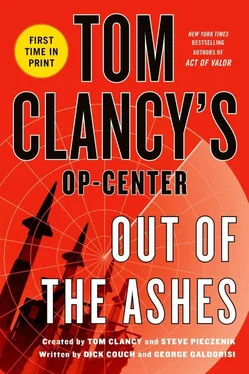When she had viewed that video as one of a dozen people crowded around a small screen eight hours ago, something had seemed a bit odd. She wasn’t sure exactly what it was, just something different. She thought back to some of her work at the National Reconnaissance Office as well as at Center for Naval Analyses with UAV communications and optics packages and knew what she had seen on that footage wasn’t quite right, but she couldn’t put her finger on precisely what it was.
Now she had these displays to herself and a bit of free time, so she kept the current Global Hawk video, which showed nothing remarkable, on one screen of her UAV monitor. She used the playback capability of the system to display the video from eight hours ago on another screen. She played it back once, and then played it back again. She wasn’t sure what she was seeing, but she was determined to keep watching it until she found out what wasn’t right about this bit of video.
* * *
Seven time zones away, in the White House Situation Room, NSC junior staffers were scrambling to accommodate the president’s most senior advisors in both secure conference rooms simultaneously. As they did, they continued to field questions from other officials too junior to be included in the top-secret meetings and secure video-teleconferences.
These more junior officials crowded into the tiny Sit Room watch floor both to monitor the action and to be close to their principals should they be needed immediately. Their demand for information and other support was nearly insatiable. Captain Joe Wexler was the Sit Room director, and his ops deputy, Rick George, had seen this all before.
“We’re in a feeding frenzy again, Captain. This place is always a zoo at times like this. Don’t worry; it will calm down eventually, it always does. What do you make of it anyway? We gonna pull the trigger this time?”
Wexler knew George’s decades-long service on the NSC staff made him an invaluable asset. On the other hand, he also realized that after seeing dozens of crises and multiple tempests in a teapot, George took everything in stride, perhaps too much so. It was his job as Situation Room director to strike a balance.
“I don’t know, Rick. We may. What that video shows us is pretty ominous. Put that together with the rhetoric coming from some groups in Syria and I think it spells trouble.”
“Do you?” George asked.
“I do. The Syrians were never our friends to begin with. You remember the Duelfer Report said that Saddam probably transferred missiles and WMD to Syria right before Operation Iraqi Freedom? We also haven’t forgotten that the Syrians weren’t any damn help to us in the aftermath of that war; more insurgents got into Iraq across Syria’s border than from anywhere else.”
“You’re right there.”
“Yes, and now this new government in Syria isn’t that warm to us to begin with and it’s clear they don’t have complete control of their country to boot. The intel we pick up from multiple sources tells us groups like Al Qaeda and Hezbollah are operating with near impunity and maybe even with a wink and a nod from the government.”
“Sure,” George said, “I get all that. Then again we’re talking about just one missile site for God’s sake, not an entire country armed to the teeth to attack us.”
“No, you’re right, but here’s the thing. Those are Chinese-made DF-21D medium-range ballistic missiles. Remember when we first learned China was testing them back in 2006? DoD and Navy officials were catatonic and began calling it the first carrier-killer missile.”
“I remember that, and I also remember it was some of their most jealously guarded technology.”
“It was, but as China’s economy continued to boom and their need for oil became nearly insatiable, they cut a deal with Iran. It was sweet deal for both parties. In return for selling Iran the DF-21D, China locked up some lucrative oil contracts with Iran.”
“Yeah, but it’s a long journey from Iran to Syria, how’d that happen?”
“Look, you’ve had an insider’s view for years regarding what’s going on in the Middle East. It’s no secret that once this new government took over in Syria, Iran wanted to ensure its equities were advanced with the government as well as with elements in the country like Hezbollah. Hell, it’s no stretch at all to think Iran put those DF-21D’s directly in the hands of Hezbollah, knowing that group wouldn’t feel any constraints using them where the new government in Syria just might.”
“No, that all makes sense.”
“And for all we know, those aren’t the only DF-21Ds they have and we’ve got three carrier strike groups in the Central Command area of responsibility in range of them. Forget about worrying over what might happen to our friends in the area. Those missiles have a range of over 1,500 miles and can easily hit Harry S. Truman pier side in Jabel Ali and likely hit our other carriers and big deck amphibious ships in the area as well. We have to take action, and soon.”
“We’re worried about what they can put on them as a warhead, too, aren’t we?”
“We sure as hell are,” Wexler continued. “Those DF-21Ds can carry a nuclear warhead and the fact that the building at that site adjacent to the missile launchers has what appears to be fissionable material in canisters stacked up all around it is the worst possible scenario. We could be looking at ballistic missiles armed with WMD, most likely a radioactive dirty bomb.”
“None of that was there as recently as a week ago.”
“Right,” Wexler continued. “The technology is pretty basic and there’s little doubt Syria can put that all together in almost no time. If they lob just one DF-21D with a dirty nuke warhead and hit anywhere near Harry S. Truman, we’ll lose hundreds, even thousands, of sailors instantly and the ship will be useless for years, maybe decades.”
“So I get it, it’s something we can’t ignore, but…,” George continued, shaking his head, clearly unable to reduce their conundrum to an easy solution.
“The problem is, Rick, for all we know, the Syrian government may just be using the ruse they don’t have complete control of their country. That way, they’ll have plausible deniability if a missile gets launched from their territory.”
“It still comes down to the question, is the threat compelling enough to make us act preemptively? Will the voices within the president’s inner circle wanting action trump those urging caution?”
“Wouldn’t shock me,” Wexler replied. “We’ve been slow to deal with these kinds of threats in the past, and look what happened. Everything I’ve heard from the National Security Council principals coming in and out of here, including the national security advisor, tells me they don’t want to be that slow again. No, my bet is we decapitate Syria, period.”
George had to admit Wexler’s arguments were hard to refute.
* * *
In the Presidential Palace in Damascus, Syria, Hafez Shaaban listened to his advisors’ arguments, but said nothing.
“Excellency, the United States is an enemy of our government, don’t you see?” the first man said.
“They didn’t like the Assad regime, but they now complain more about the supposed chaos of our country,” another advisor added.
“Something has caused them to issue threats against us, there’s no doubt about that,” the first man said.
Even though he was an Alawite, Shaaban had been an early leader in the uprising against the Assad dynasty during the Arab Awakening in 2011. Now he led the brittle, cobbled-together coalition of Alawites, Shias, Druse, and Christians that was attempting to govern the country. Unlike other new leaders in the Mideast, Shaaban had never lived abroad. In fact, he had never been outside the borders of Syria, save for regular religious pilgrimages to Saudi Arabia. Shaaban was focused on internal matters. He had much to do inside of Syria’s borders to cure it of so many years of despotic rule.
Читать дальше












